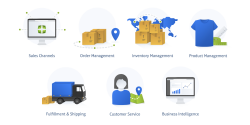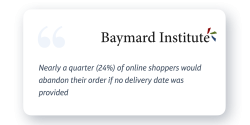How to DOP? – Leveraging Key Features
In the previous part of this blog series, we talked about how the Digital Operations Platform is a centralized system that provides businesses with a comprehensive solution to manage their commerce operations. By unifying data streams, automating important operations, and offering flexibility and scalability, DOPs enable businesses to reduce costs, increase productivity, and provide exceptional customer experiences. But how exactly can a DOP be used? That’s what we will explore in this blog article.
Features of Digital Operations Platforms
Digital Operations Platforms (DOPs) offer a range of features that help businesses streamline their back-office operations. These features can help businesses to automate their workflows, reduce errors, and increase productivity. These are some of the key features of the DOP:

Sales Channel Management
A DOP enables businesses to manage multiple sales channels from a single platform. This includes marketplaces such as Amazon and eBay, social media platforms such as Facebook and Instagram, and the business’s own website.

In short a DOP:
- Allows businesses to easily manage and track their sales channels, whether it’s through a website, marketplace, or social media platform.
- Provides a centralized platform for businesses to manage sales channels, making it easier to track sales, inventory, and orders across multiple channels.
- Helps businesses to expand their sales reach by easily integrating with new sales channels as needed.
How to DOP: Order Management
Order management is a crucial component of a DOP. It enables businesses to track orders from various channels, manage order fulfillment and shipping, and handle returns and cancellations.
In short a DOP:
- Streamlines the order process, from placement to fulfillment, reducing errors and increasing efficiency.
- Provides real-time order tracking, ensuring customers are always aware of their order status.
- Allows businesses to manage complex order scenarios such as multiple shipping addresses, split shipments, and partial refunds.
Inventory Management
Inventory management is another essential feature of a DOP. It enables businesses to track their inventory levels across multiple sales channels, set up automated replenishment, and manage stock across different locations.

In short a DOP:
- Provides real-time inventory tracking and visibility, enabling businesses to optimize their stock levels and reduce stockouts.
- Allows businesses to track inventory across multiple locations, reducing the risk of overselling
- Provides advanced inventory forecasting and planning tools, helping businesses to make data-driven decisions to optimize their inventory levels.
How to DOP: Product Management
Product management is a critical feature that helps businesses to manage their products across multiple sales channels. It enables businesses to create and manage product listings, track product performance, and update product information in real time.
In short a DOP:
- Provides a centralized platform for businesses to manage their product data, making it easy to create, update, and manage product listings across multiple channels.
- Helps businesses to optimize their product catalog by providing data-driven insights into product performance and customer behavior.
- Allows businesses to easily manage product variations, bundles, and kits, ensuring accurate and up-to-date product information is always available.
How to DOPL Fulfillment and Shipping
Fulfillment and shipping are important components of a DOP. It enables businesses to manage their order fulfillment process, including pick, pack, and ship and provides visibility into the status of each order.

In short a DOP:
- Streamlines the fulfillment process, reducing errors and increasing efficiency.
- Provides real-time shipment tracking, ensuring customers are always aware of their shipment status.
- Enables businesses to easily manage multiple shipping carriers and services, providing flexibility and choice to customers.
How top DOP: Customer Service
A DOP can also help businesses to provide excellent customer service. It enables businesses to manage customer inquiries, handle returns and cancellations, and track customer interactions across multiple channels.
In short a DOP:
- Provides a centralized platform for businesses to manage customer inquiries, complaints, and returns, ensuring timely and efficient resolution.
- Enables businesses to track customer interactions and behavior, providing insights into customer needs and preferences.
- Allows businesses to provide personalized customer experiences by storing customer data and preferences in one place.
How to DOP: Reports and Analytics / Business Intelligence
Finally, a DOP provides businesses with a range of reports and analytics that can help them make informed business decisions. It provides real-time visibility into critical data such as sales performance, inventory levels, and customer behavior.
In short a DOP:
- Provides real-time data and insights into key business metrics such as sales, inventory, and customer behavior, enabling businesses to make data-driven decisions.
- Helps businesses to identify trends and opportunities, enabling them to optimize their operations and increase revenue.
- Provides customizable dashboards and reports, enabling businesses to easily monitor their performance and identify areas for improvement.
Overall, these key features of a DOP help businesses streamline their back-office operations, reduce errors, and increase productivity.
DOP – A crucial part of your operations
In conclusion, Digital Operations Platforms (DOPs) provide businesses with a centralized solution to manage their commerce operations efficiently. With features such as sales channel management, order management, inventory management, product management, fulfillment and shipping, customer service, and reports and analytics, DOPs enable businesses to streamline back-office operations, reduce errors, and increase productivity.
Ultimately, investing in a DOP can be a game-changer for businesses looking to stay competitive and grow in today’s fast-paced digital landscape.
In the third part of this blog series, we will focus on how to choose the right DOP for your business. Also, we will explore best practises for implementing a DOP within your organization.
If you’re interested in learning more about how Marello DOP can help your business, please don’t hesitate to contact us. Our team of experts is ready to answer any questions you may have and help you get started on your journey to digital transformation with a DOP.
Retour au blog